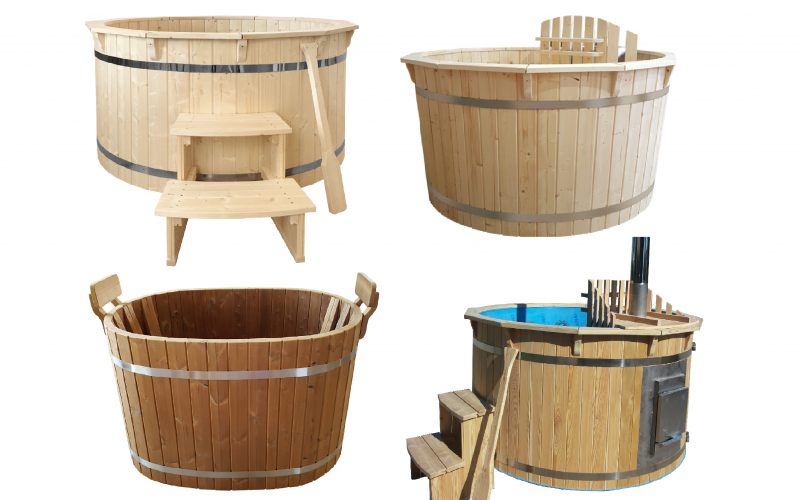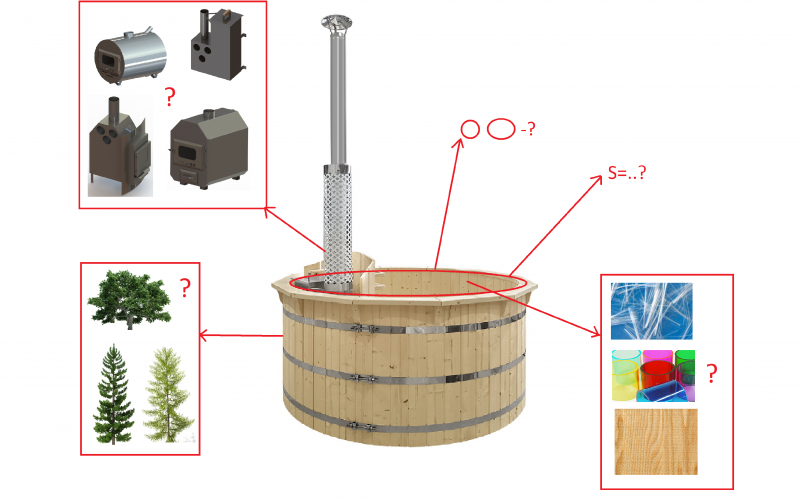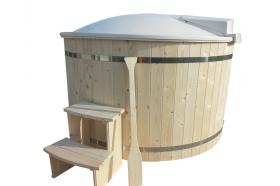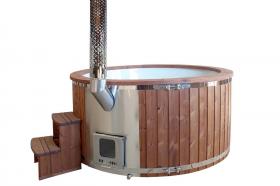
VARIETY OF TUBS
A long time ago the tub was a round or oval-shaped container for storing liquids or bulk products. Now the tubs are made much larger, even up to 220 cm in diameter, 110 cm high and are used for bathing! A hot tub is a great choice for enjoying hot water in your yard, garden or spa. If you have already selected the model you want, contact us to make your purchase. If you cannot decide, we also look forward to receiving your email and are ready to answer any questions you may have.
The production of our wooden hot tubs is very precise and responsible work, so much of the cutting and assembly operations would not be possible without the help of human hands. The tub structure is assembled with a solid bottom and wooden planks placed around it. These are tightened with stainless steel rings.
All tubs that we sell can be made of spruce, larch or thermo wood. Each species has its own benefits but in terms of durability, thermo wood takes the first place on the list.
We produce round, oval and conical wooden tubs as well as tubs with plastic and glass fiber inserts. For those who like bubble hot tubs, we offer a jet system for the tub.
The water in the tubs is heated by internal or external heaters that are fired by firewood. The internal heater takes up the space of 1-2 people in the tub, but there are no pipes or heaters around the outside of the tub. An external heater increases the space available inside the tub, but 2 pipes and the heater are located on the outside. Some small tubs can only have external heaters, but in all other cases, the heating function of both types of heaters is done in the same way.
The hot tub is suitable for both urban and rural environments. Such a unique accessory will not create a spa oasis in your space, providing comfort and performing a decorative function.

HOW TO CHOOSE A HOT TUB
The 2 main criteria to consider when choosing a tub are the type of tub and the number of people that will occupy it. For example, oval tubs fit up to 2 people, so to accommodate more people, round or conical tubs are a better choice as they fit up to 10 people. Each tub may have plastic or glass fiber inserts. We can always advise you in order to make the search easier.
Each of our tubs can be fitted with an air jet system and / or a hydro massage system to enjoy the jacuzzi pleasures of the tub.
The jet system consists of an engine and an air vessel network, the ends of which are integrated into the sides or bottom of the tub. The engine is a small compressor that compresses air that travels through the vessels and through the water to create bubbles. The entire system is hidden at the bottom and in an additional cavity on the side, so the appearance of the tub is practically unchanged.
The water massage system provides an intense flow of water. Water is pumped and sprayed through nozzles to the required parts of the body. The jets are not only pleasant, but the massaging is a healthy function for the body.

HOT TUB CARE AND USE
The tub should first be placed on a solid and stable base. More care is required for pure wood tubs. Tubs with plastic or glass fiber inserts can be kept both in the winter and in summer without water. In winter, the water in such tubs should not be allowed to freeze, as the ice will damage the tub inlay and heater. A wooden tub without inserts must always contain water in the summer. Without water, the tub may dry up causing the wood to shrink and leave gaps. The tub must also be cleaned. If you do not clean the tub it will get dirty and look unappealing. In winter, such a tub should be kept without water, because frozen ice can break the tub as well as its heater. Wood will be more durable if it is always soaked.
As a rule, the more natural something is, the more care it requires. Hot tubs with plastic or glass fiber inserts require less maintenance, less cleaning, they do not dry up in the summer, and are not required to be filled with water all the time.
When in use, the water level should be about 10 - 15 cm from the top. The water must not flow over the top. Such criteria are a guide for a sufficient amount of water in the tub. It is particularly important that the heater is fully submerged, and in the case of an external heater, the water level should be higher than the upper hose.
Failure to assure such conditions can cause damage to the heater. The wood paddle is designed for ensuring the water in the tub heats evenly. The purpose of the tub lid is to help the water to heat up faster and keep the water hot for longer. Water heating in the tub can take from 2 to 6 hours, depending on the weather conditions and the size of the tub.
We recommend coating the outer part of the tub with natural oil for longevity. A tub not in use should always be covered to protect it from environmental harm and to ensure that children do not fall into it. The tub is to be built no less than 4 meters away from any buildings. Do not jump into the tub. The recommended temperature of the water is no more than +41°C.
Wood Colors

Frequently Asked Questions And Common Mistakes
- A wooden hot tub is most natural, has its healing properties from the natural tree but its care and cleaning are more complicated.
- Looking at the easiest maintenance and cleaning, tubs with plastic or fiberglass liners are more convenient because they require less attention. The tubs with liners are easy to clean and in this case, they are more hygienic. Buying a tub with such liner avoids the soaking procedure and can be used immediately after connecting the heater stove.
- Fiberglass hot tubs consume less water and at the same time heats up the hot tub faster.
- Internal heater. The firewood is placed and the stove is cleaned up over the top so sometimes ash can fall inside the tub. The internal stove takes one person’s place in the tub but saves space in the yard or terrace.
- Internal heater with external furnace. The firewood is placed and the stove is cleaned on the outside of the tub. Easier to access, cleaner water. Also, the inside heater takes one person’s o place in the tub.
- External heater. External heater saves space inside the tub and has convenient access for firing. This kind of tub is more relevant in less-used homesteads where the extended periods the stove can be disconnected and transported to a safe warm place.




